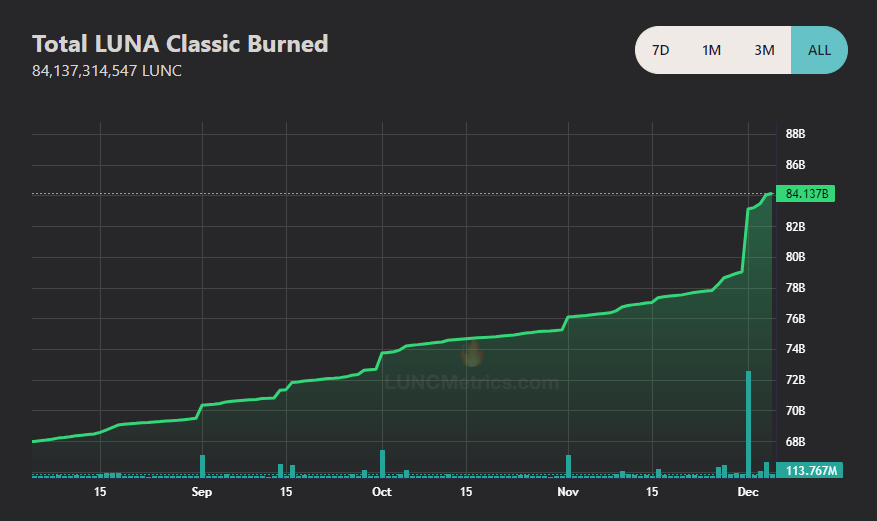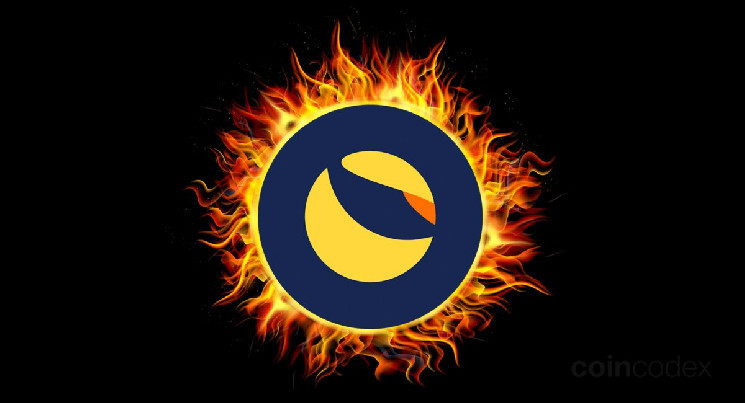As of October 2023, more than 74.6 billion LUNC have been burnt, with an average burning rate of more than 95.8 million LUNC per day. Despite the high burn rate, there are still more than 5.8 trillion LUNC in circulation, up from just 380 million in May 2022.
Following the collapse of the Terra Classic ecosystem in May 2022, the supply of the native governance and utility token LUNC became massively inflated, leading to a monumental price crash. Trying to save the ecosystem and restore the price of LUNC, the community passed a vote to enact the Luna Classic burn tax, which introduced a fee on all token transactions and reduced the circulating supply by over 84 billion LUNC.
With that in mind, how do Terra Classic burns actually work? Will the LUNC burn tax manage to reign in the hyperinflated supply? What's the effective LUNC tax rate? Read along to find out.
Key takeaways about the LUNC burn:
- LUNC burn is a blockchain feature of the Luna Classic network that sends 0.5% of each LUNC transaction to a burn wallet
- The burn tax is used to reduce the hyperinflated supply of LUNC, which increased from 400 million to over 6.5 trillion following the USTC de-peg in 2022
- The tax was initially set at 1.2%, later lowered to 0.2%, and stands at 0.5% as of May 2023
- So far, nearly 84.1 billion LUNC tokens (worth more than $18.4 million at current market rates) have been sent to the burn address
- On average, roughly 95 million LUNC tokens are burned each day, and over 2.88 billion per month
- At the current burn rate, it would take more than 100 years for the LUNC supply to decrease to 10 billion coins, which is the stated target of the Luna Classic community
What led to the hyperinflated supply of LUNC?
Luna Classic is a decentralized, consensus-based blockchain protocol that operates on a secure proof-of-stake consensus mechanism. It has been designed to facilitate low-cost and secure transactions, with near-instant confirmation times.
After USTC lost its $1 peg in May, the supply of LUNC increased drastically, trying to restore the peg. But to no avail. When all was said and done, LUNC’s circulating supply increased from less than 400 million to over 6.5 trillion in a matter of 72 hours. As a result, LUNC's price plummeted from over $100 in April to less than 1 cent about a month later.
In the aftermath, the original blockchain rebranded to Terra Classic (LUNC). Meanwhile, the original Terra (LUNA) naming was assigned to a new blockchain that launched in June 2022 with no algorithmic stablecoin functionality.
What is the Luna Classic burn tax? Deflationary pressure for LUNC
The Luna Classic burn is a unique coin burn feature, which is designed to reduce the circulating supply of tokens while increasing their value. The Terra Classic network has had a LUNC burn tax of 0.5% since May 2023.
Initially, the LUNC burn rate was set to 1.2% of each transaction. The rate has later been changed to 0.2% in order to encourage more activity on the blockchain. However, the low tax rate had very little effect on the circulating supply of LUNC. In March 2023, an active Luna community member filed a proposal to lift the LUNC tax rate to 0.5%.
The proposal to bring the Luna Classic burn tax to 0.5% eventually passed in May 2023, with the backing of major crypto exchanges, including Binance and KuCoin.
The Luna Classic burn mechanism works by automatically burning tokens whenever a transaction occurs on the network. The number of tokens that are burned is relative to the number of tokens in circulation. This ensures that the total supply of tokens is constantly decreasing, thus increasing their value over time.
Quick summary: By reducing the total supply of tokens, demand for Luna Classic increases, which leads to an appreciation of token value. In addition, the burn mechanism creates deflationary pressure on the token, as the total supply of tokens decreases over time.
The Luna Classic team has also developed a series of other mechanisms to increase the scarcity of their tokens. These include algorithmic buybacks that are triggered when certain conditions are met, such as when the price goes above a predetermined level. This helps to ensure that Luna Classic tokens remain scarce and valuable for the long term.
Furthermore, some exchanges like Binance are implementing the Luna Classic burn mechanism even on trades facilitated by the exchange. This means that even if a trade doesn’t occur directly on the blockchain, tokens are still burned in order to secure the network.
When is the next Luna Classic burn and where can I follow the Luna Classic burn chart?

Over 84 billion LUNC have been burned so far, according to the Luna Classic burn tracker. Source
If you are wondering when the next Luna Classic burn will take place, the answer is simple – Luna Classic burn is an automatic, continuous process that is being carried out daily.
The Luna Classic burn status is tracked by various websites that provide users with a chart that displays the number of tokens that have been burned since the burn mechanism initially went live, such as LUNC Burner. This allows users to track the burn progress and get a better understanding of the burn mechanism.
The Luna Classic burn chart also displays information about when and how many tokens were burned for each transaction. This allows users to keep track of the current state of Luna Classic tokens and their deflationary nature. By understanding the deflationary nature of Luna Classic tokens and their burn mechanism, users can better understand why reducing the circulating supply is important for increasing their value over time.
It is worth noting that Binance, accounting for 70% of all trading volume in the space, has committed to carrying out LUNC burns on a monthly basis. Every first day of the month, Binance calculates the total amount of LUNC to be burned based on trading fees from the previous month and sends it to a burn address.
How many LUNC tokens have been burned so far? Luna Classic burn chart

As of November 2023, roughly two-thirds of LUNC burned has been sent to a dead wallet directly, while about a third has been burned via the transaction tax. Source
The total amount of LUNC tokens burned so far is approximately 84.1 billion, or roughly 1.23% of the total supply. Binance is said to have burned 33 billion LUNC tokens as of June 2023, which accounts for about half of the total tokens burned by that point in time.
It is worth noting that the rate of Luna Classic token burns decreased after proposal “5234” was enacted, which reduced tax burn from 1.2% to 0.2%. However, a later proposal by "dfunk" (called "New Economic Policy for Terra Classic") brought the tax rate to 0.5%.
The daily burning rate is approximated to be $5,500 worth of LUNC. According to some estimates, the tax burn rate could gradually increase to 5.2% in the future, which would drastically increase the number of Terra Classic burned each day.
LUNC burn rate is, however, not only limited to exchanges, but it is also implemented by the Luna Classic network itself. This means that when a transaction occurs on the blockchain, tokens are burned automatically. This is done in order to ensure that the total supply of tokens is constantly decreasing, thus increasing their value over time.
Here's a closer look at how many LUNC tokens have been burned so far:
- Total LUNC burned: 84,085,638,625 LUNC
- LUNC burned on-chain: 30,471,406,019 LUNC
- Sent to LUNC burn wallet directly: 53,665,908,528 LUNC
- The total value of burned LUNC: $18.7 million
The bottom line: Can Luna Classic burns help increase the price of LUNC?
The LUNC burn is a unique approach to reducing the circulating supply of tokens and increasing their value over time. By burning a portion of tokens every time someone trades on the blockchain, Luna Classic can reduce the total number of tokens in circulation and ensure that users are rewarded for holding onto their coins. Many users hope that the burn tax will be instrumental in helping LUNC recover to its former glory.
While it is hard to imagine Luna Classic reaching $1 or even $0.10 given its current tokenomics (at $1, LUNC would have a market cap of over $5 trillion, which just isn’t feasible), the price of LUNC is predicted to increase substantially in 2023, in large part thanks to Luna Classic burns. This is one of the reasons why LUNC is currently among the best cryptos under 1 cent.
 coincodex.com
coincodex.com
